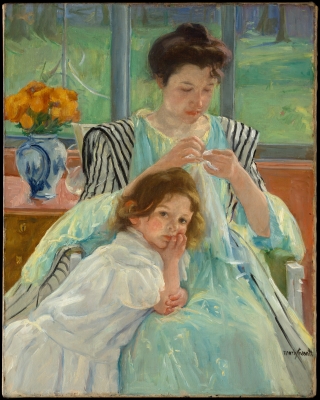
Mary Stevenson Cassatt was an American painter and printmaker. She was born in Allegheny City, Pennsylvania (now part of Pittsburgh’s North Side), but lived much of her adult life in France where she befriended Edgar Degas and exhibited with the Impressionists. Cassatt often created images of the social and private lives of women, with particular emphasis on the intimate bonds between mothers and children.
Cassatt grew up in an environment that viewed travel as integral to education; she spent five years in Europe and visited many of the capitals, including London, Paris, and Berlin. While abroad she learned German and French and had her first lessons in drawing and music. It is likely that her first exposure to French artists Jean Auguste Dominique Ingres, Eugène Delacroix, Camille Corot, and Gustave Courbet was at the Paris World’s Fair of 1855. Also in the exhibition were Edgar Degas and Camille Pissarro, both of whom were later her colleagues and mentors.
Cassatt traveled to Chicago to try her luck, but lost some of her early paintings in the Great Chicago Fire of 1871. Shortly afterward, her work attracted the attention of Roman Catholic Bishop Michael Domenec of Pittsburgh, who commissioned her to paint two copies of paintings by Correggio in Parma, Italy, advancing her enough money to cover her travel expenses and part of her stay. In her excitement she wrote, “O how wild I am to get to work, my fingers farely itch & my eyes water to see a fine picture again”. With Emily Sartain, a fellow artist from a well-regarded artistic family from Philadelphia, Cassatt set out for Europe again.
Cassatt saw that works by female artists were often dismissed with contempt unless the artist had a friend or protector on the jury, and she would not flirt with jurors to curry favor. Her cynicism grew when one of the two pictures she submitted in 1875 was refused by the jury, only to be accepted the following year after she darkened the background. She had quarrels with Sartain, who thought Cassatt too outspoken and self-centered, and eventually they parted. Out of her distress and self-criticism, Cassatt decided that she needed to move away from genre paintings and onto more fashionable subjects, in order to attract portrait commissions from American socialites abroad, but that attempt bore little fruit at first.
In 1877, both her entries were rejected, and for the first time in seven years she had no works in the Salon. At this low point in her career she was invited by Edgar Degas to show her works with the Impressionists, a group that had begun their own series of independent exhibitions in 1874 with much attendant notoriety. The Impressionists (also known as the “Independents” or “Intransigents”) had no formal manifesto and varied considerably in subject matter and technique. They tended to prefer plein air painting and the application of vibrant color in separate strokes with little pre-mixing, which allows the eye to merge the results in an “impressionistic” manner. The Impressionists had been receiving the wrath of the critics for several years. Henry Bacon, a friend of the Cassatts, thought that the Impressionists were so radical that they were “afflicted with some hitherto unknown disease of the eye”. They already had one female member, artist Berthe Morisot, who became Cassatt’s friend and colleague.
Picture Credit : Google

